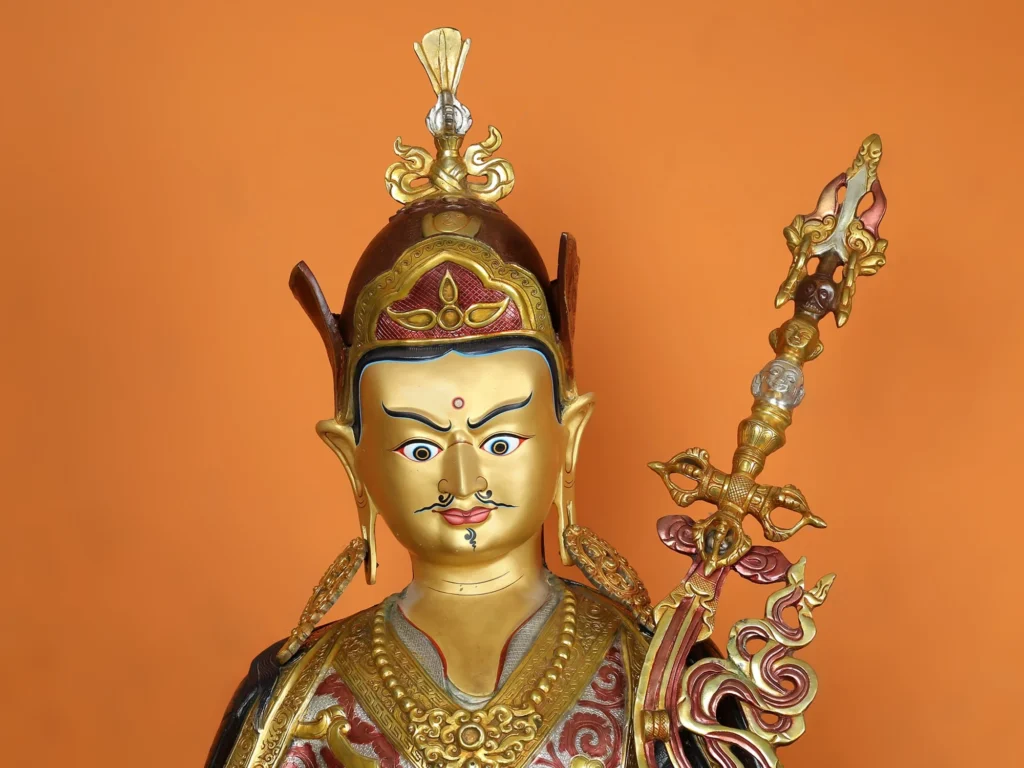Nestled in the heart of Medog County, on the slopes of Dolmala Mountain to the southeast of Medog Town, stands the Rinchen Pung Monastery, a serene sanctuary perched at an altitude of 2038 meters. The revered Kambu Lama from the Kham region founded this sacred site, embracing the Nyingma sect of Tibetan Buddhism. Initially, the monastery stood as a three-story structure with 12 walls and four gates facing the cardinal directions, known as “Dewang Rinchen Pung” (meaning the central temple), and Tibetan Lamas managed it.
Unfortunately, the original building was destroyed in the massive Medog earthquake of 1950 but was later rebuilt. Today, it houses several gold-plated copper Buddha statues, symbolizing the resilience and spiritual dedication of the community.
Spiritual Hierarchy and Roles at Rinchen Pung
The monastery is a hub of spiritual learning and religious practice, with a hierarchy that reflects social status, skill, religious knowledge, and seniority. At the apex is the “Tulku” or Living Buddha, who signifies the ascent of souls to heaven to rejoice with the gods. As the highest authority, they oversee all monastery affairs and have a thorough knowledge of the scriptures.
Just below the Living Buddha are the “Paju,” who are knowledgeable in scriptures and rich in religious understanding. They manage various religious ceremonies and tasks within the monastery. This group includes roles such as “Dorje Lobon” (master of rituals), “Chunba” (monk inspector and alms collector), “Gelong” (scholar monks), “Umze” (cymbal player), and several others responsible for musical instruments, security, and maintenance of the temple’s sanctity.
“Nyeba,” the monastery’s stewards, manage the economic aspects, and “Gone” take on the general upkeep tasks, including fetching water, delivering messages, cleaning, cooking, and safeguarding food supplies.
A Visit to Rinchen Pung: A Journey Into Spiritual Tibet
Visiting Rinchen Pung Monastery offers a unique glimpse into the spiritual heart of Tibet. The monastery is not just a place of worship, but a living community where each role contributes to the seamless operation and maintenance of spiritual practices. From the sound of rituals resonating through the air to the serene presence of the gold-plated statues, a visit here is a journey into tranquility and tradition.
If you feel drawn to the spiritual teachings, have an interest in Tibetan cultural practices, or are simply searching for peace, Rinchen Pung Monastery stands as a must-visit destination, offering a unique blend of spirituality, culture, and natural beauty.
Nestled within the tranquil environs of Medog County, Rinchen Pung Monastery stands as a testament to the spiritual heritage and agrarian lifestyle that has defined the region for centuries. At the monastery, the “Sbrag-pa,” or ordinary monks, play a vital role not only in religious ceremonies but also in the daily sustenance of the community. These monks, when not engaged in large-scale religious events as performers or musicians, dedicate themselves to farming on monastery lands, harvesting crops, and performing various tasks, including studying scriptures. Unlike the “Sprul-dku” or Living Buddha who leads the monastery, most Lamas live at home, engage in labor, marry, and have children, only coming to the monastery for prayer during religious festivals.
The Majestic Dharma Assembly: A Glimpse into Tibetan Ritual
The Rinchen Pung Monastery is renowned for hosting the “Mainba Dharma Assembly,” a solemn and dignified event lasting five days. The assembly features the “Decham” (fertility dance) and “Shawa Cham” (deer dance) on the first day, followed by the “Bardo” drama, depicting hunting scenes and the hunters’ judgment in hell for their actions, on the second and third days. The fourth day showcases the “Shanak Cham” (black hat dance) by 12 to 16 dancers, culminating with the “Dorjee Droloe” (Vajra deity dance) on the fifth day, a performance that imbues a sense of divinity and authority with dancers dressed in satin, adorned with brocade aprons embroidered with Buddhist images, and wearing a copper mirror on their chest.

Nyingma Sect: The Ancient School of Tibetan Buddhism
The Nyingma sect, recognized as the oldest school of Tibetan Buddhism, cherishes the teachings of Guru Padmasambhava as its founding master. The term “Nyingma” signifies “ancient” or “old” in Tibetan, reflecting the sect’s adherence to the original tantric teachings. Focusing on the practice of Dzogchen or “Great Perfection,” the Nyingma tradition considers the “Eighteen Great Scripture Collections” its core, although it commonly practices only eight. These include practices devoted to Manjushri, Padmasambhava, and various deities and rituals aimed at achieving enlightenment and benefiting all beings.
Loosely organized followers marked the Nyingma sect’s early history until figures like Zurpoche Shakya Jungne and Srophugpa Shakya Sengge established significant monasteries in the 11th century. It wasn’t until the 16th and 17th centuries that the sect saw the establishment of larger scale monasteries, such as Dorje Drak near Lhasa by Tashi Tobgyal and Mindrolling Monastery in Zhanang by Kume Tsultrim Gyatso. The Fifth Dalai Lama also contributed to this expansion by founding Namdroling Monastery. Today, more than 340 Nyingma monasteries spread across Tibet, serving as spiritual havens and centers of learning.
Engaging with Tradition: Tips for Visitors
Exploring the Rinchen Pung Monastery and learning about the Nyingma sect offers a profound insight into the rich tapestry of Tibetan Buddhism and its vibrant cultural heritage. We encourage visitors to immerse themselves in the monastery’s peaceful yet potent atmosphere, witness the intricate rituals, and appreciate the profound teachings and practices preserved through the centuries. This journey into the heart of Tibetan tradition not only educates, but also inspires a deeper connection with the spiritual and cultural dimensions of this unique region.

